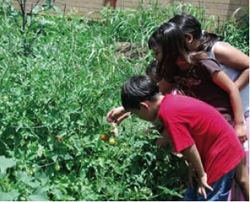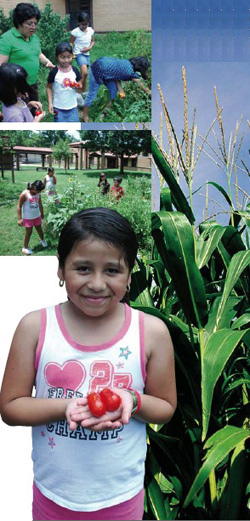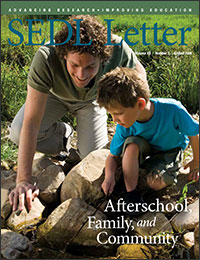Teacher, Mira Mis Plantas!

Alexandra Mendoza teaches her students at Metz Elementary math, science, and language skills while they work in the garden.
One week before the end of school, when most teachers would find it challenging to keep their students’ attention, veteran teacher Alexandra Mendoza has no such problem. Her second graders eagerly wait their turn to sample one of the tomatoes they just picked from the vegetable garden outside their classroom. After eating the golf ball-sized red and yellow tomatoes, many students ask to take some home. One second grader wants “one for mami, one for dad, and one for baby brother.” Because of the bountiful harvest, Mendoza is happy to send the students home with tomatoes, green beans, and cucumbers.
Mendoza teaches at Metz Elementary in Austin, Texas. Her garden is a collaboration between her class and Green Corn Project (GCP), an Austin nonprofit that installs organic food gardens for families and individuals in need as well as for schools and community centers. Since 1998, GCP has installed more than 150 organic food gardens throughout central Texas. The organization focuses its efforts on underserved areas of the capital city, where people often lack access to fresh and affordable organic vegetables.
Five years ago, GCP decided to expand its efforts beyond backyard gardens into schoolyards in the same underserved areas. The goal for the expansion was two-fold: (1) to introduce students at a young age to the benefits of fresh vegetables and the joy of gardening, and (2) to have the students teach their parents about these benefits. GCP currently supports 25 garden beds at 16 area schools.

“We’re trying to educate central Texans about how to grow organic food gardens, so it just makes sense to start with the kids,” explains executive director Meagan O’Donnell. “The students love it. They go home and share their gardening knowledge—and their vegetables—with their families.”
In 2005, GCP garden coordinator Wayne Kamin approached the teachers at Metz Elementary with the idea of putting in a garden. Metz fits GCP’s criteria for inclusion: 94% of the students are economically disadvantaged, and two thirds are classified as “at risk.” Mendoza embraced the idea. She had already been gardening with her classes for a few years, but her students were often frustrated with the slow pace of the garden installation. With no adults to help her prepare the bed, Mendoza found it taking at least 1 month to get the garden ready for planting. Her students were always asking, “When do we get to plant?”

With GCP’s help, Mendoza is now able to plant right away with her students. On weekend “dig-in days,” GCP volunteers spend about 4 hours preparing the school’s garden. The volunteers double dig the bed—a labor-intensive method of loosening and aerating the soil that allows roots to grow deeper and access water more easily. Double digging is part of the biointensive method that GCP employs. This method, which also includes the use of compost, the hexagonal spacing of plants, and companion planting—placing plants that grow well together near each other—creates gardens that yield large harvests. It requires less maintenance and water than traditionally dug gardens. For school gardens like the one at Metz, the volunteers double dig the bed, add compost, and leave starter plants and seeds for the teachers to plant with their students (for the family and individual gardens, GCP volunteers help the garden recipients plant the starters and seeds).
GCP volunteers return to the school at the start of each growing season—in March and September—to refurbish the bed, add more compost, and drop off more starter vegetables and seeds. Through volunteer mentors, the organization also offers gardening advice throughout the season.
Mendoza has also recruited her own volunteers for the garden building. Last summer, Austin’s unusually high rainfall turned the garden area into a jungle. Her students’ parents came with their machetes to the dig-in and quickly cleared the area. Mendoza has also asked other teachers, including her fellow second-grade teacher Eva Rosenthal, to help expand the garden area. This fall the school’s courtyard will have four GCP beds, two for the second graders and two for the third graders, as well as a butterfly garden to attract monarch butterflies on their annual migration.
The students learn about far more than gardening by working in the beds. Mendoza and Rosenthal use the gardens to teach the students about math, science, and biology. For example, the students must use math to divide up the garden bed. They measure the bed using irregular measurement tools, like links and cubes, and then move on to using inches and centimeters. GCP beds are normally 4 feet by 12.5 feet; 4 feet is about how far the arms of an 8-yearold can reach into a bed without stepping in it and compacting the soil or plants. Once the students have measured out 1 square foot, that area becomes their individual garden space where they plant beans and melon.
“Some of the plants are for us—we take them to our families. The other squares are for the other class,” explains second grader Francesca. “We share with the kindergarteners.”
The second graders also teach the kindergarteners what they’ve learned about gardening. Vicky, Isaac, and Nelsy advise, “Don’t rip the leaves off. Don’t step on the plants. Be really careful with them,” while Carmen, Dulce, and Daisy suggest, “Have fun! Take care of the plants. Give them water.” Francesca and Isabel offer information that even some experienced gardeners and vegetable eaters might need to know: “Some tomatoes are yellow, but the red ones have to be really red.”
In addition to science and math, gardening provides the Metz second graders with a lesson in language. More than 96% of the school’s students are Hispanic, and 44% have limited English proficiency. Through gardening, however, they learn that coliflor is “cauliflower” in English. As they learn about the difference between good bugs and bad bugs, they learn the names of bug body parts in both English and Spanish. And along with discovering that empanadas taste better when made from fresh homegrown (or is it school-grown?) vegetables, they learn that the word “empanadas” is the same in both languages.
Moreover, Mendoza and Rosenthal have seen their students become enthusiastic fruit and vegetable eaters. The children love picking and eating the vegetables they have grown and sharing their harvest with other students and their families. In the end, GCP is happy to support school gardening efforts. Kamin said, “The garden knowledge lasts longer than when the students are in school; it lasts more broadly. When the students help put a seed in the ground, see it sprout, see it bud, see it bloom, and see it fruit, it expands their awareness and makes a difference.”
GCP takes its name from an American Indian celebration designed to secure the blessing of the Great Spirit for a bountiful crop. Like the ceremony, GCP works to spread hope by teaching people of all ages skills that can be used for self-empowerment and self-reliance for years to come.
Suzanne Hurley is a board member of Green Corn Project (GCP) and a freelance writer. GCP is a volunteer-driven organization, with only one part-time employee. For more information about GCP, visit the organization’s Web site at www.greencornproject.org.
Next Article: Does Homework Improve Academic Achievement?: If So, How Much Is Best?

